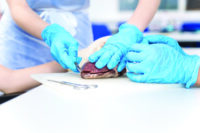It’s not your parents’ biology
High school biology can no longer consist merely of traditional lecturing, dissecting frogs, viewing prepared slides, or reducing scientific learning to simple rote memorization. Finding the angle that intrigues even the most uninterested student is the key to successful instruction and comprehension of biological concepts.
We all possess an element of curiosity. This “curiosity factor” in students is constantly stimulated by news and crime scene investigation shows. Biology teachers, working in the resulting time frame, can leverage this interest to teach their subject matter. Utilizing forensic science to reinforce biological concepts, especially those in genetics, adds excitement and understanding back to the classroom.
DNA technology is a powerful tool in identifying suspects, convicting the guilty, and exonerating the innocent. Investigators need knowledge of DNA technology and the ability to locate DNA before cracking the case. Students learn these concepts and, consequently, biology classroom learning gains purpose and value.
Carolina® Forensic Kits help students learn why and how
Carolina’s Exploring Electrophoresis and Forensics Kit (item #211012 and #211014) and PCR Forensics Simulation Kit (item #211213) are 2 effective and engaging activities that help make this connection. Exploring Electrophoresis and Forensics Kit is a great introduction to DNA technologies used in forensic investigation, while the PCR Forensics Simulation Kit requires an understanding of the purpose of PCR and its use in generating human DNA profiles.
We can always ask students to simply compare DNA samples, but we help stir interest and alleviate curiosity by asking them to compare samples to solve a mystery. Using the Exploring Electrophoresis and Forensics Kit, students:
- Cast agarose gels
- Load precut DNA into the gels
- Perform electrophoresis
- Interpret the banding patterns to determine if one of the suspects’ DNA profiles matches crime scene evidence
The Demo Kit (item #211012) contains enough materials for 2 demonstrations, while the Classroom Kit (item #211014) contains enough materials for 10 student groups.
3.3 billion base pairs, but how many really count?
Most students understand that DNA is the basic building block for an individual’s entire genetic makeup and that each person’s DNA is unique. However, many students fail to understand that only a portion of the 3.3 billion base pairs possessed by an individual is different from other individuals. Thus, a major challenge with using DNA in forensic analysis is detecting these differences. Fortunately many of the differences are concentrated at specific regions along chromosomes. Scientists are able to look at these regions of genetic variation through an advanced DNA technology known as polymerase chain reaction (PCR).
PCR is a form of “molecular photocopying” as it uses repeated cycles to reproduce a target area of DNA until enough copies are available for analysis. The selective nature of PCR results from the use of primers that are complementary to the regions targeted for amplification.
Who done it?
The PCR Forensics Simulation Kit appeals to the curiosity factor and enhances student understanding of DNA and DNA technologies by requiring students to utilize this gathered information to solve a fictitious murder. In the activity, students conduct electrophoresis of purified DNA samples that simulate the result of PCR DNA fingerprints from crime scene evidence and 2 suspects, X and Y.
The crime scene evidence and suspect DNA were analyzed with 2 sets of primers. For a suspect to match the crime scene evidence, the PCR products from primer pair 1 must match evidence 1, and the products from primer pair 2 must match evidence 2. The materials in the PCR Forensics Simulation Kit are sufficient for 6 lab groups or 6 teacher demonstrations of the experiment.
An excellent investigation for students to conduct either before they begin the Exploring Electrophoresis and Forensics Kit or PCR Forensics Simulation or while their gels are running is Caught by a Kiss (item #212015). Teachers may use this activity prior to the other labs to simulate the collection of evidence containing DNA, since students will actually analyze DNA evidence in the other labs. Moreover, this lab can enhance students’ understanding of enzyme activity, as they analyze evidence for the presence of saliva amylase, an enzyme found in human saliva.
Don’t stop now
Students are more likely to learn and make connections when the subject matter interests them. Carolina offers a number of instructional resources to reinforce not only genetics, but other topics taught in the biology classroom as well. For everything you need to teach biology, including kits and free activities, visit Carolina.com.
Author
Angela M. White
Carolina Teaching Consultant






